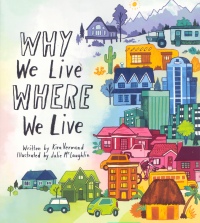| ________________
CM . . . . Volume XXI Number 13 . . . . November 28, 2014
excerpt:
Expanding on the seemingly simple question of why we live where we live, this book uses an 'outside in' approach to explore every aspect of our home environment beginning with the essential conditions that make Planet Earth habitable. It examines basic climate, geography, food and water needs that influence our choices in general. Moving into specifics, it describes how energy sources, language, and the history and design of cities influence settlement. It delves into availability of money, jobs and immigration options. A couple of chapters describe some infamous choices to live near active volcanoes, the effect climate change is having on livable locations, and explains what we know about other potentially habitable planets in space (including an observation on asteroids from Chris Hadfield's International Space Station experience). An interesting feature of the book is the discussion of how a location's personality—culture, activities, attitudes—determines the appeal of a place to live. So many reasons for our choices of where to live make us all individuals and accounts for a variety of reports of 'the best place to live'. The book also delivers a conservation message by encouraging the reader to consider environmentally friendly options to the ways we live; e.g. choosing to live and work near jobs (or working from home) to reduce fuel consumption, and suggesting the use of locally seasonal produce when costs of shipping become unreasonable. After explaining why many settlements began near water, examples are given of how some locations far from rivers or lakes have adapted by building dams and reservoirs to bring necessary water closer. Both pros and cons of each topic are examined, and reader questions are well anticipated. How will Las Vegas solve its impending water shortage, for instance? The author poses the question of whether "extreme urban planning" that includes such over-consumption is wise. The design is appealing with small chunks of text, bulleted lists, and it is enhanced with liberal use of illustrations. For instance, in the chapter on 'Food in All the Right Places', a diagram-style presentation shows how oranges move from tree through shipping to distribution center to grocery outlet to your plate. This makes the details accessible to a range of reading and interest levels. Clever subheadings add to reading appeal: e.g 'Power Gives Us a Buzz', and 'Money is a Roam'n Numeral'. Concisely written but packed with a wealth of up-to-date information, Why We Live Where We Live has excellent potential to spark discussions among young readers as they consider their identity, their relationships with other people and cultures, and how they might want to influence the future of living situations. By examining where we live, and why, we learn more about our attitudes and further our understanding of the global community. Highly Recommended. Gillian Richardson is a freelance writer living in BC. Copyright © the Manitoba Library Association. Reproduction for personal use is permitted only if this copyright notice is maintained. Any other reproduction is prohibited without permission.
Next Review |
Table of Contents for This Issue
- November 28, 2014. |
